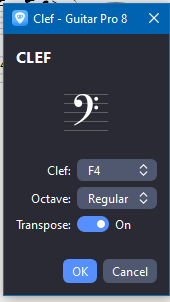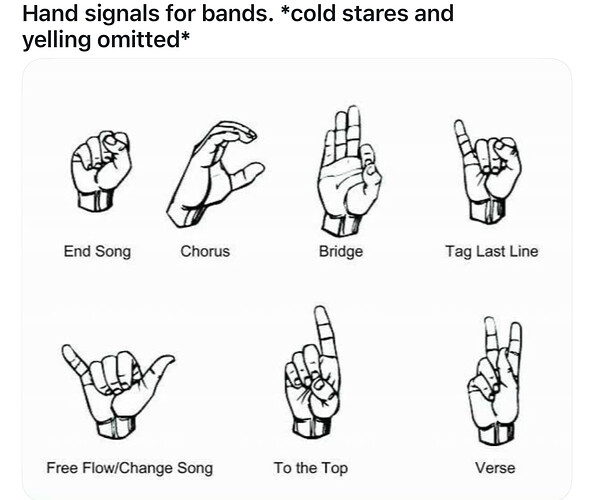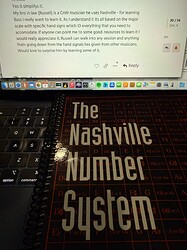the tabs are fine
And…scene.
ok I’ll take that ![]()
I think what came from songster was just tabs, yes? When you load those in to GuitarPro (or probably any other notation software) they will, by default convert the tab to treble clef notation. There is nothing in the tab to actually tell it otherwise. You need to make the change to bass clef which is very easy. Click the treble clef and in the dialog box change the clef from G2 to F4:

Yes, correct!
I mostly use tabs from here: https://ignition4.customsforge.com/ (load the in Tonelib and export to GPx).
But sometimes I use the free download trick above for Songsterr. It results in a GPx (Guitar Pro) file.
This is the first case that it showed a treble clef instead of a bass clef - though it’s marked as bass in Songsterr…
It’s not the first case of incorrect tabs though ^^
I started with a similar brain dump, but it got really long (even for me).
I find that I think most naturally and quickly in terms of intervals and relationships. I only really worry about the note or the string/fret for the root of the song. From there, it’s all relational - 3rd, 5th, 7th, Octave, etc. Changes are usually “Then I go to the 4-chord, and I’m going to play the 3rd and fifth of that.”
When I’m thinking of pitches, I normally think in terms of the phonetic scale - “Doh, Re, Mi, Fah, Sol, Lah, Ti, Doh”.
Learning, I start with the simplest things and broadest strokes and then throw in additional detail. So: Root → Chord Changes → Key → a few broad chordal shapes → fills and frills.
Building things out that way helps me understand the songs better and what the original artist was doing. It means I can dial up or down the complexity as necessary. I also always have something memorized I can fall back on.
Notated music can help me with how I learn. But it can get confusing in situation like the bridge of the song in question, “Seether” - where the bassist clearly didn’t have a predefined line, but is taking changes and moving around arpeggiating a lot of tones around those chords. Tab or notation means I have to more brute force memorize.
That’s what lead to this question. Figuring out tricks to peel back to find the structural bone underneath.
How high do you have to be to transcribe a song in the wrong clef?! And yet they did so correctly. Bizarre. Maybe the work of AI?
This is WHY we have a bass clef! And WHY bass is transposed an octave up! To avoid having to read all those ledger lines. ![]()
In the future, when someone asks why not to use Songsterr, maybe I’ll just show them this. ![]()
This slash sign viiø7 is the sign for half diminished 7th chord not triad, the intervals are from root minor 3rd, Diminished 5th and minor 7th =1 b3 b5 b7
The diminished 7th chord (no slash viio7) from root are root minor 3rd, Diminished 5th and diminished 7th =1 b3 b5 bb7 a stacked series of minor 3rds. Its worth noting that there really only 3 (dim7’s) Co C#o Do in existence. the enharmonics might spell it differently but theyre all the same notes. Why is this important, because if you are working rhythm with any comping muscicciian all you got do keep your ears open and stick to the dims n Doms I am only just learning Bass but have played Trumpet for a while. ![]()
![]()
![]()
![]()
You are correct.
I believe that the author of the quoted theory explanation excerpt was referring generally to diminished chords as a separate type versus major and minor chords, not distinguishing between a dim chord and a half dim chord. Maybe she didn’t want muddy the water in reference to her general theory explanation? Dunno. Otherwise, it is clear and succinct info.
Hi Mike
Yes it simplifys it.
My bro in law (Russell) is a CnW musician he uses Nashville - for learning Bass I really want to learn it. As I understand it its all based on the major scale with specific hand signs which ID everything that you need to accomodate. If anyone can point me to some good. resources to learn it I would really appreciate it. Russell can walk into any session and play anything thats going down from the hand signals hes given from other musicians. Would love to surprise him by learning some of it.
Jeez I wish my old band used these!!
It was a lot of "Hey! Hey!! HEY!!! " and frantic arm waving to get someone’s attention!!
LMAO!!
“Hey! Hey! HEY!!!” is tried and true.
And the last one was usually tagged with “Asshole!”
This is fact! ( from experience ) ![]()
![]()
![]()
I first thought that was a mousepad ![]()
Thanks so much for the info, have checked it out on Amazon UK and Ive ordered it.
Steve
That brilliant Mike thanks.
Steve
I would highly recommend that book, I used it with my Berklee Prof Danny “Mo” Morris.

